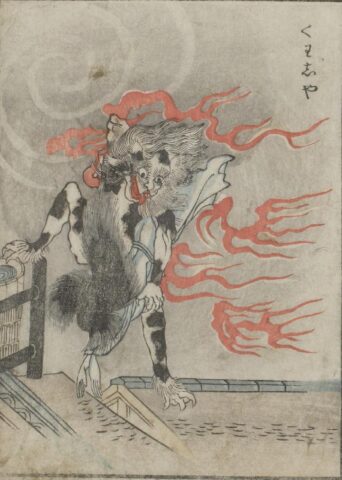
Download
Venue
DIJ (access) and online
Registration Info
This is a past event. Registration is no longer possible.
DIJ Mailing Lists
Please subscribe below to stay informed about our research activities, events & publications:
Death and the Cat in Japanese Folklore
April 23, 2025 / 18:00h (JST) / 11:00h (CEST)
Jenny Willett, University of Cologne / DIJ Tokyo
Japan’s cats dance and talk and the grudge they hold is legendary. Since at least the Heian period the cat is known as a mysterious being in Japan, said to have a heart and spirit resembling that of humans, blessed with both intelligence and soul. As in many cultures, the imagery of the cat in Japan is highly ambiguous: it is marked both as protective kami and ferocious yôkai that haunts the house and kills its owners to take on their shape. But Japan’s felines hide a much darker secret: They are viewed as necromancers, soul stealers, body snatchers. In Japanese folklore it is considered taboo to bring a cat close to the body of a deceased out of fear that it might take control over them.
This presentation took a closer look at one aspect of the cat’s strong association with death through the lens of the Kasha, a former Buddhist demon that took on the shape of a supernatural cat sometime during the late 17th/early 18th century. The demon Kasha’s purpose was to take the souls of the dead to hell in, as the name suggests, a fiery wagon where they would be punished for their sins. However, Kasha’s only aim as a yôkai is the stealing of the bodies of recently deceased, to maul and potentially even feed on them, disrupting funerals and summoning thunderstorms. Together with the well-known story complex of the “Neko danka” or the Cat Parishioner the motif of the bodysnatching Kasha served as an example of how cats appear in the popular culture of the Edo period as a representation of Japanese folklore.
Jenny Willett, a doctorate candidate at the University of Cologne, has focused on stories and myths about cats in Japan through the lens of “Demonic Cats in Japanese folklore” since her Master’s studies at Eberhard-Karls University of Tübingen. She now delves deeper into this research topic to understand the strong connection of cats with the aspect of death, especially of the so-called cat yôkai in their fully developed state of the Edo period. Since October 2024 she has been a PhD student at the DIJ Tokyo.